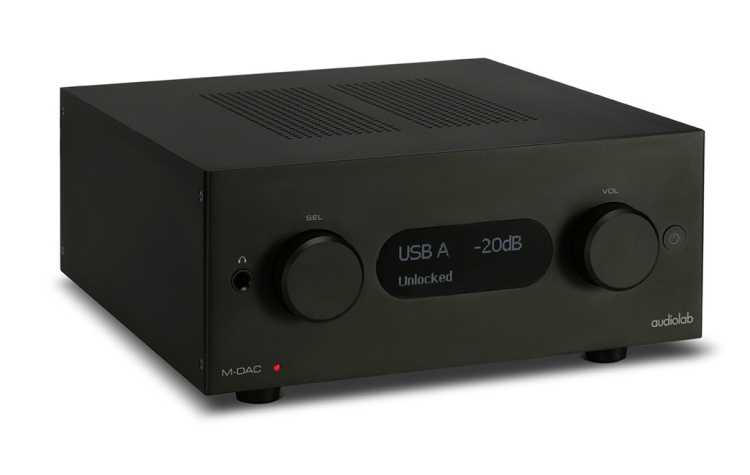
Affordable Jack of all Trades with a detailed and refined sound
Retail price in the Netherlands 1149 euro
Review sample kindly supplied by Quad-raad.nl
Conclusion updated 27-03-2017 (opinion unchanged, but motivated more clearly)
A true British brand, Audiolab became famous with their succesful 8000A amplifier. Company ownership changed hands in 1997 and the name changed to TagMcLaren, only to emerge again in 2004 when Audiolab became part of IAG and the original name was restored. As part of IAG, Audiolab once again produce high quality hifi at affordable prices.
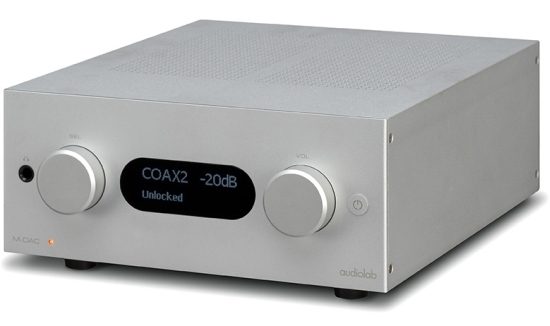
When unpacking the M-DAC+ one immediately notices the weight and the structural integrity. This DAC is put together really well, with thick aluminium panels not just for the front panel but for the entire enclosure, which is decidedly non-ringy. Peeking through the vent holes in the back I see solid electronics and large cooling towers: this is no empty box. According to the specs there is a toroidal transformer with muliple windings and multiple regulated power supply sections, a proprietary discrete master clock and a JFET Class A output stage. All this is pretty confidence inspiring.
Like the large majority of DACs out there, the Audiolab employs a Delta Sigma DAC chip. This principle is currently subject to debate, with a growing camp stating that true multibit ladder DACs are the better way to go. While supported by sane theory, the reality however is that true multibit DACs are very labour-intensive to get precisely right and thus are very expensive. In anything but the most esoteric high end, Delta Sigma is simply the most cost effective way to still achieve excellent results. By the way, I have heard both good and bad Delta Sigma DACs just as I have heard good and bad multi bit DACs. The implementation really plays a large role in this. In any event, Audiolab have selected the hottest brand in Delta Sigma DAC chip of this time, the ESS Sabre32 9018.
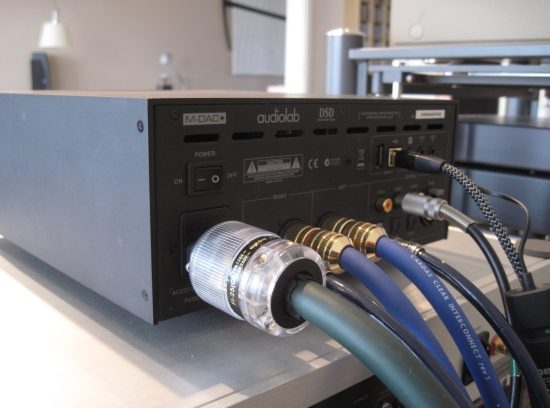
Connectivity is excellent with 1x USB for a computer source, 1x USB for an i-Device, 2x coaxial, 2x optical and AES/EBU inputs. Outputs are available in cinch and XLR. There’s a proper IEC inlet that is spaced such that it allows for the beefiest of connectors.
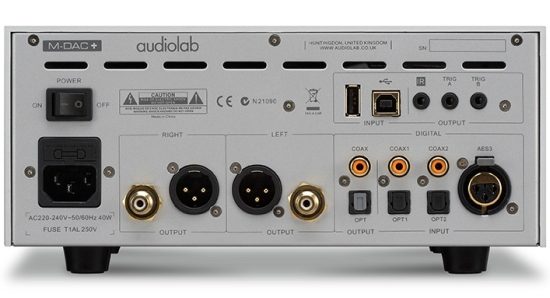
The M-DAC+ processes audio data up to 32-bit/384kHz via USB and offers compatibility with DSD64, DSD128 and DSD256. What’s really nice is that the reconstruction filters can be adjusted: there are 7 filter settings for PCM files and 4 more for DSD playback. Using these filters, you can make the M-DAC+ sound sharper or smoother, more articulate or more rounded, just as you see fit, or as the recording requires.
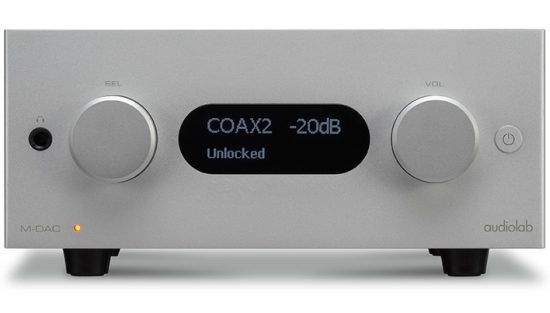
Operation couldn’t be simpler: the two large rotary knobs do it all. So when you can’t locate your remote control, all functionality can still be set on the unit itself. Left knob selects input or the menu items, right knob controls volume in the digital domain and mute, when pushed. These knobs by the way are not plastic, but feel like solid metal and they operate smoothly, without any wobble.
The M-DAC’s output level is fully adjustable, but can also be set fixed at either 0dB or +3dB. The latter can sound more powerful but is only advisable when the matching preamp or integrated amp is known to have enough headroom to cope with this signal. In the majority of cases 0dB will provide the best solution.
There’s a very interesting setting called Jitter Rejection that can be set to Low, Medium or High Bandwidth. As I did not have the remote control at hand I had to switch between these modes by using the buttons on the front panel. I tried it a few times back and forth but I can’t say that I heard a repeatable difference. That said these results might differ when using a lower quality source, but I did not try this.
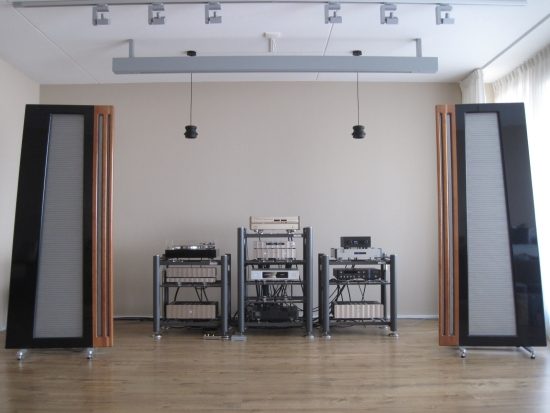
Review Setup: Apogee Diva, Artesania Racks, Jeff Rowland amplification
Sound
Used with a Furutech Alpha 3 power cable and Cardas Clear XLR interlinks, and using the Aurender N10 as a source playing 16/44 files either with spdif coax or via an Audioquest Diamond USB, the Audiolab M-DAC+ has a sophisticated and refined sound with extended airy treble and lots of definition, and no harshness whatsoever. This open character extends to the midrange, that straddles the middleground between being very detailed and being laidback. The midrange is not warm or lush in the stereotypical English manner, but also not in your face or grainy or anything, and it leaves no doubt about this DAC’s resolving power. The bass is a tiny bit lightweight, mostly due to there not being any excess oomph in the upper bass, but it is highly articulate, fast and well-timed. Soundstaging is not particularly opulent or room-filling but otherwise very precise, with excellent center imaging focus.
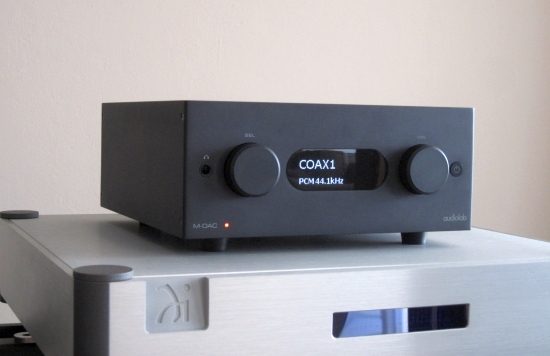
While the above may lead one to believe the M-DAC+ to be an analytical or even clinical sounding DAC, this is not the case. The M-DAC+ sure is very neutral, but it also sounds natural and I am quite impressed by its refinement and convincing timbre. Now don’t misunderstand this by thinking that the M-DAC+ sounds ballsy or richly colourful, but more in terms of sounding natural and not synthetic at all. This I think is an achievement in itself because this is precisely the area where many other DACs let down, even some expensive ones.
Of all the filter settings I mostly preferred the Optimal Transient setting, as it made for the most articulate sound. For timbre in the midrange however I found the Minimum Phase setting to sound slightly better. This is just something that you should experiment with, to find your own preference.
There was a subtle difference in sound between Coaxial Digital and USB, the latter sounding slightly tighter and more accurate and the former sounding slightly more rounded. Much like the digital filters, this is a matter of taste, and the choice is yours.
The M-DAC+ is also capable of playing hi res PCM and DSD files, but I did not try this. The M-DAC+ itself is inherently very highly resolving meaning that when playing true hi-res files, it may well provide staggering levels of resolution. But alas, I did not try this. But hey, this leaves a nice exercise for the prospective to discover.
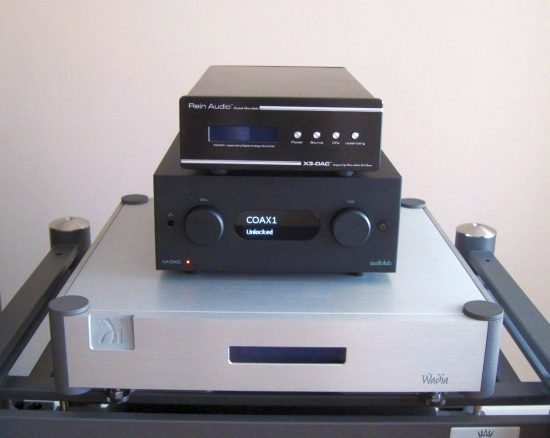
Comparisons
Naturally I compared the M-DAC+ to my reference DAC and CD player, and while the Wadia 521 and Mark Levinson 390S both sounded better to my ears in their own ways, this is of no real relevance because firstly these units are in a different universe in terms of pricing and secondly they are no longer available. Let’s compare to some more recent DACs that are closer in price.
In terms of outstanding neutrality, the M-DAC+ is reminiscent of the Aurelic Vega. Although the M-DAC+ is not quite as expressively (some will say forward-sounding) detailed or dynamic as the Vega, the M-DAC+ seems to me to be less clinical and arguably more forgiving.
The Ayre QB-9 has a similar presentation in terms of midrange purity and overall tonality, as well as the same overall level of detailing, but the M-DAC+ does have a tighter, more solid quality to it while the Ayre has an overall more loose-coupled, “free flowing” character.
The PS-Audio NWD has beefier bass and a fuller overal tonality and an overall more powerful delivery, but not quite the M-DAC’s level of neutrality, resolution and refinement.
The Exogal Comet I feel presents a match for the M-DAC+, providing the same overall quality and outperforming it in terms of dynamic differentiation, resolution and finesse.
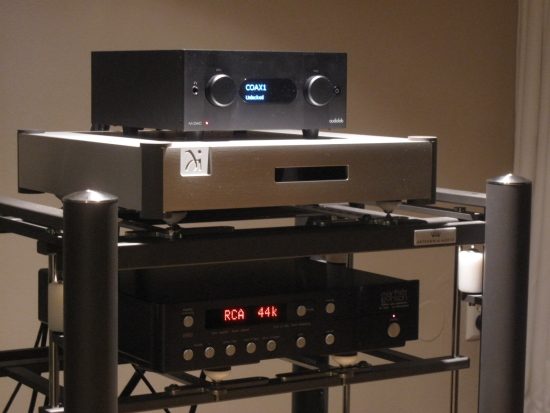
Finally I pulled out the Rein Audio X3 DAC. This DAC’s strong area, neutrality, still holds up well, but otherwise the X-DAC surpassses it quite easily in terms of finesse, refinement and detailing.
Conclusion
It seems evident that over the years, DAC quality has really improved a lot, especially at the more affordable end. There still are and probably always will be audible differences between DACs, and there will always be the high end segment providing ever wider perspectives. But the M-DAC+ just offers great value for money and clearly shows that near-reference quality articulation, transparency and resolution can be had at an extremely reasonable price.






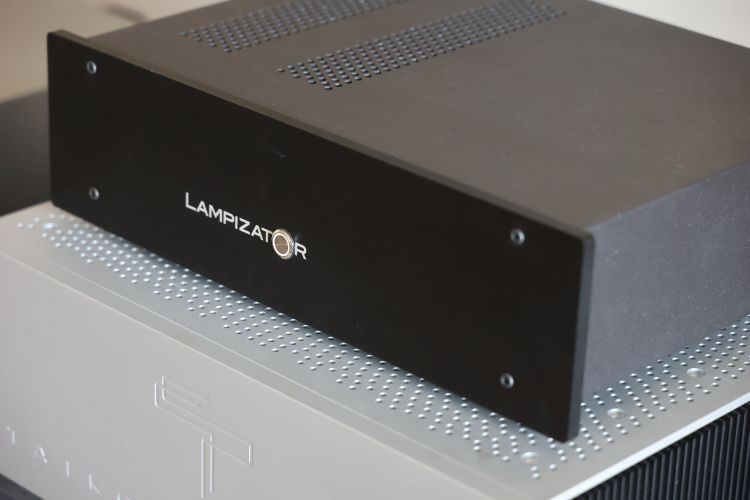
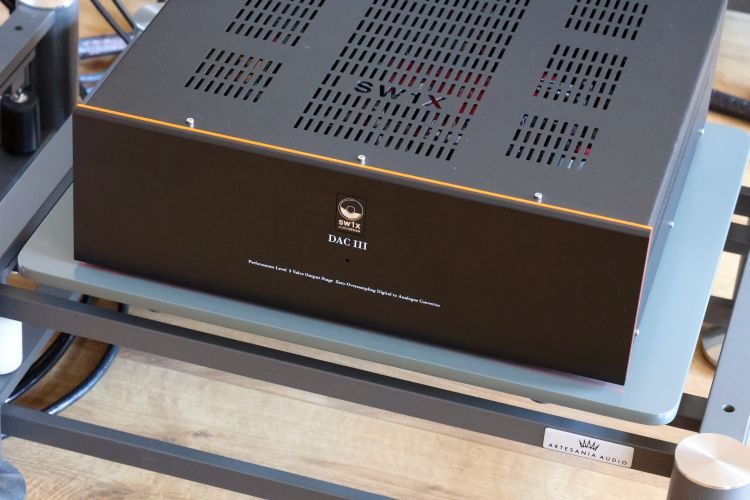
Hello Cristiaan, I am thinking about the replacement of my “old” Chord Dac64 (connected to my Mac mini with first Hiface usb) due to drivers problems with OSX El Capitan.
I have doubs between Chord 2qute and Audiolab M-Dac+.
Both similar prices.
What do you think? Can you advise me?
Hi Francisco, I haven’t used the Mac with the HiFace EVO for about a year but do know that M2Tech released new drivers for OSX not too long ago, fixing issues with the then recent OS, I believe it may have been Mavericks. On the other hand, in my experience the sound always benefits when avoiding the USB to SPDIF conversion stage, so a new DAC with USB would seem like the best route to take. Not having heard the 2qute (none of the Chord DACs actually) it is difficult for me to advise properly. Having read all that was published about all of Chord’s DACs though I have a feeling that the DAC64 is quite a different animal than the more recent 2qute and M-DAC+. I would expect the latter two to sound leaner and more upfront than the DAC64, especially when using long buffer times. As for deciding between the 2qute and the M-DAC+ I really couldn’t say based on sound quality, but I would note that the M-DAC offers more functionality as well as balanced outputs.
Hi again Chistiaan,
Thanks for your comments.
I am considered also the purchase of the Mojo Audio Mystique DAC v.1. The owner of Mojo Audio, Benjamin Zwickel, is against DSD, Delta Sigma chips, and noise-shaping, upsampling, or oversampling algorithms.
My quetions are:
– Have you heard Mojo´s DAC? Do you think there are big differencies in sound with above Audiolab and Chord 2Qute due to the implementation of R-2R multibit ladder chip?
– In your opinión, is it true that R2R chips sound more natural tan Delta Sigma chips? and what is your opinión about this debate?
– Also, what is your opinión between PCM vs DSD? It really deserve to buy a DSD DAC?
Thanks in advance for your advises and opinions?
Francisco.
Hi Francisco,
I have not heard the Mojo Audio Mystique v1. As outlined in the review above I have heard good and bad Delta Sigma designs and good and bad multibit designs. There is certainly a movement toward reappraising the merits of true multibit conversion, and for sound reasons. But the success is very much determined by the implementation, and both conversion methods have their pros and cons. True R2R is potentially the best solution (refer to MSB DACs which are considered to be the current best) is very difficult to get right, meaning that the resolution is not necessarily as high as advertised, and the precision might also drift under influence of temperature. There is much more to say about this but suffice to say that there are challenges to both designs. Going out on a limb here but likely multibit is only truly at an advantage in costlier equipment. Regular readers will know I am not crazy about DSD, mostly because I find DSD bass to be typically less solid than PCM, but also because my system already has excellent resolution even with 16/44 material. I am also not normally a fan of Delta/Sigma / bitstream conversion, but I am definitely very fond of the Mark Levinson 390S CD player, which uses a hybrid Delta Sigma converter. This player has a smoother, more relaxed sound than the more accurate Levinson 360S DAC, which has multibit converters. Also I am was very impressed with the PS Audio PWD MKII which actually sounds very Wadia-like and the Meridian Ultra DAC, which even beats my Wadia 521 in terms of bass solidity and dynamics. Surprisingly, both these DACs use a Delta Sigma converter.
Whether or not to go for DSD is something you should investigate yourself. If you like hi res PCM then you might also like DSD. There is no denying that DSD can provide higher resolution than 16/44, as can hi-res PCM files, but you have to make sure to obtain true hi res files, not upconverted ones, and your DAC needs to have the resolution to do these files justice. Don’t underestimate this last factor as many DACs struggle to obtain true 16 bit resolution, let alone 24 or higher. This is a complex matter but if you are interested there are various forums where this is explained at length.
Getting to your question of whether multibit sounds more natural: this is impossible to answer because there are many aspects of “natural” and what one person finds to sound convincing, the other need not. If fluidity and refined treble are indicators for you that the sound is natural, then the majority of Delta Sigma DACs would sound very natural to you. If you find however that tonality/timbre is more important for your sense of realism, or if you like solid/sonorous bass, then you may find multibit conversion to sound more convincing. Again: the conversion method is only one part of the story. The power supply and output stage are also hugely important. That said overall I tend to prefer multibit, when properly implemented, as ecvidenced by my preference for Wadia DACs, which use multibit indeed. All things being equal, I have a feeling that Delta Sigma processing cannot entirely have the same solid feel especially in the bass and lower midrange as can multibit conversion, but this is only a hunch, not a fact!
Mr. Punter: You state:
” Like the large majority of DACs out there, the Audiolab employs a Delta Sigma DAC chip. This principle is currently subject to debate, with a growing camp stating that true multibit ladder DACs are the better way to go. While supported by sane theory, the reality however is that true multibit DACs are very labour-intensive to get precisely right and thus are very expensive.”
NOT SO. Schiit (USA) have Mult-bit DAC offerings starting at $249.00 US$ –as of February, 2017.
Secondly, did you actually ‘”review” the Audiolab M-DAC+ resting upon another component –as seen in the photograph ?
peter jasz
I am not saying that there are no good affordable multi bit DACs. I am saying that “the large majority of DACs out there… use a Delta Sigma DAC chip”. Do cheap multibit DACs get it right also? This remains to be seen. However Schiit is certainly on my radar. Time allowing and if they agree I intend to investigate this matter some more using their DACs.
The MDAC+ was reviewed same as all other components: using the Exoteryc’s top level feet. I failed to make photo’s of this though.
Hi Christian: Interesting. You note that you compared the M-DAC+ to your Wadia/Levinson. I see you have no ‘extra’ shelving on your audio stand –how did you compare the two then ?
One (DAC) must have been positioned somewhere else. In which case, this represents a very unfair comparison –knowing the considerable impact a premium Hi-Fi stand/rack imparts
Please clarify.
Thanks,
peter jasz
It’s simple: the Wadia was removed to make room for the MDAC+.
Mr. Punter: I’ll start (and end actually) with some of your words:
” The bass is a tiny bit lightweight, mostly due to there not being any excess oomph in the upper bass, but it is highly articulate, fast and well-timed. Soundstaging is not particularly opulent or room-filling but otherwise very precise, with excellent center imaging focus.”
( I believe the LF performance/sound simply is more refined, nuanced, layered and textured than many previous players/DAC’s. The light-weight nature of the bass ( I like and understand the term) I suspect represents a far more accurate reproduction, offering up enormous gains in nuance, articulation, layering, definition and clarity.
I mention this because many “newer” audio components (including preamplifier, power amp and loudspeakers designs –from respected/talented designers) also reveal this greatly improved LF quality that some refer to as a”deficiency”. Not so. Not even close.
The “lightness” I suspect is the subjective response (by some listener’s) of reduced/minimized or eliminated LF colorations from this very, very important frequency spectrum.
As you (correctly I suspect) pointed out, the M-DAC+ has a nuanced, textured and layered quality in the LF region. That some (of the better) current designs have tackled and ovecome these colorations is a major step in the right direction.
In fact, this lower midband of frequencies is absolutely critical, serving as the foundatoin for all that rests upon it –the remainder of the critical mid-range of frequencies.
It appears to me that many listener’s refer to this quality “light-weight bass” as a deficiency when in fact it is a highly desireable chacteristic.
Moving on, you state:
” …Now don’t misunderstand this by thinking that the M-DAC+ sounds ballsy or richly colourful, but more in terms of sounding natural and not synthetic at all. This I think is an achievement in itself because this is precisely the area where many affordable DACs let down.”
( Only affordable DAC’s let down ? Perhaps quite a few expensive ones as well. No?)
Continuing:
” ….The M-DAC+ is also capable of playing hi res PCM and DSD files, but I did not try this. My system inherently has very high resolution so I don’t generally crave higher res files so much. The M-DAC+ itself is also very highly resolving meaning that when playing true hi-res files, it may well provide staggering levels of resolution. But alas, I did not try this. But hey, this leaves a nice exercise for the prospective to discover. ”
(Umm, …” My system inherently has very high resolution so I don’t generally crave higher res files so much”
(What in the world does that mean? It makes no sense ! Explain that, for your readers)
Conclusion
” Do you see what’s going on here? (I honestly wish I did with this review) Although there are still audible differences between DACs, and there will always be a cost-no-object segment to provide even wider perspectives, the subjective differences in quality are becoming quite small. It seems evident that over the years, DAC quality has really improved a lot, especially in the more affordable end. Especially in the field of refinement and resolution, one needs not spend zillions anymore. Fuller tonality, or a more powerful delivery can be had, but at what price? The M-DAC+ can be had for 1149 euro while the first DAC I heard to really challenge it costs 2590 euro. Need I say more?”
(Yes. You do need to say more. Much more. Earlier in the review, you mentioned it would be unfair to compare the M-DAC+ to more expensive DAC’s.
And yet, in your concluding statements you state:
” … and there will always be a cost-no-object segment to provide even wider perspectives, the subjective differences in quality are becoming quite small.”
(WHAT ? Even wider perspectives yet subjective differences are quite small?)
Christian, unlike your excellent (2009) review on Digital Cables –that was very, very well done, this review leaves much to be desired.
Although I was left with a reasonably good impression on the M-DAC+, the remainder of the review was not only all- over-the-map, but contradictory in and of itself. Very confusing.
peter jasz
Hi Peter, thank you for your comment. You make some valid points, I see that the review can be made to be more coherent. I will re-edit soon.
Without altering my opinion, the conclusion has been updated to more clearly relay my observations.
Is it compared to the ps audio nuwave dac or dac dsd?
The NuWave DAC was reviewed long ago and the PS Audio DirectStream DAC was reviewed later and not available at the same time as the M-DAC+. So, no direct comparisons were made. That said, the DS DAC really is in another league price-wise and performance-wise. Between NuWave DAC and M-DAC+ it would come down to taste. The former is darker and drier, but nicely sonorous and solid sounding and the latter is more transparent, more open and airy.